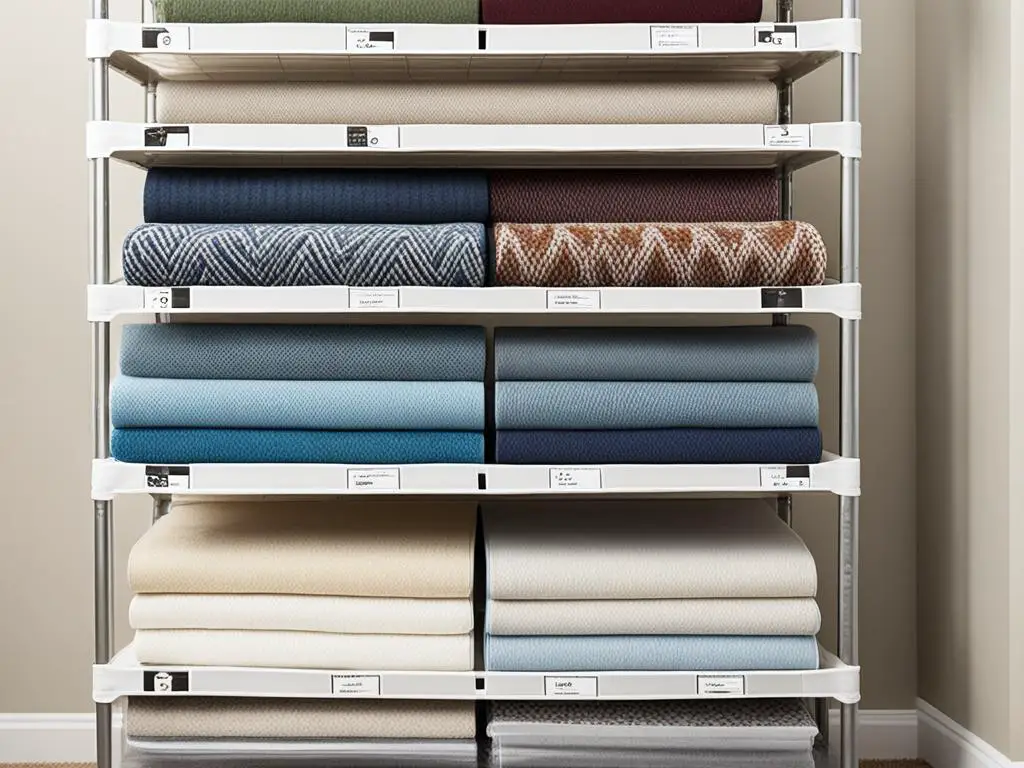Proper rug storage is essential for preserving the beauty and quality of your carpets. Stored rugs can lose their shape, attract pests, and accumulate odors if not stored correctly. Learning how to store rugs correctly is crucial to extend their lifespan and maintain their integrity. Follow these expert tips to ensure your rugs are safely stored.
Key Takeaways:
- Proper rug storage is crucial to preserve the quality and longevity of your carpets.
- Rolling rugs is preferable to folding them to prevent creases and fiber damage.
- Storing rugs vertically helps maintain their shape and optimize storage space.
- Avoid wrapping rugs in plastic, as it traps moisture and can lead to mold growth.
- Regularly inspect and unroll rugs to check for moisture, mold, or pest infestation.
Is It Better To Roll Or Fold A Rug?
When it comes to storing rugs, the method you choose can significantly impact their condition over time. One common question that arises is whether it is better to roll or fold a rug for storage. Let’s explore the best practices for rug storage to ensure your rugs remain in optimal condition.
Rolling: The Ideal Rug Storage Technique
Experts agree that rolling a rug is the preferred method for storing it. Rolling helps prevent creases, cracks, and other damage to the delicate fibers, ensuring the longevity of your rug. By rolling the rug into a cylinder shape, you not only protect it from unnecessary wear but also make transportation and storage more convenient.
By rolling your rug, you reduce the risk of wrinkles or permanent creases that may occur when you fold it. This practice is particularly important for larger rugs.
However, if you have smaller rugs that need to be stored in drawers or on shelves, folding may be necessary. In such cases, it’s crucial to avoid sharp creases that can weaken the rug’s structure and cause permanent damage.
Factors to Consider when Folding:
- Choose areas that place minimal stress on the rug.
- Avoid sharp folds that can result in creases.
- If folding a large rug, it’s preferable to fold it with the pile facing inward to protect the delicate fibers.
- Consider using acid-free tissue paper or towels to separate folded sections and provide additional cushioning.
A Visual Comparison: Rolling vs. Folding
| Rolling | Folding |
|---|---|
| Easy transportation and storage | Avoid sharp creases |
| Reduced risk of damage | Suitable for small rugs in drawers or shelves |
As visually depicted, rolling your rug allows for easy transportation and storage while reducing the risk of damage. On the other hand, folding is suitable for small rugs when space is limited but requires careful attention to avoid sharp creases.
“Rolling rugs for storage is the best way to maintain their condition, preventing creases and ensuring easy storage and transportation,” says Jane Anderson, a rug preservation specialist.
For long-term rug storage, rolling is the most effective method. It’s important to note that you should consult manufacturer guidelines or seek professional advice to ensure you’re following the best storage practices for specific types of rugs.
Can I Store A Rug Standing Up?
One of the common questions when it comes to rug storage is whether it is safe to store a rug standing up. The answer is yes, but it’s important to follow a few guidelines to ensure the rug remains in good condition.
Storing a rug vertically is generally the best way to maintain its shape during long-term storage. When storing a rug standing up, it’s crucial to prop it in a corner to prevent it from toppling over. This simple step can help prevent any accidental damage to the rug and ensure it remains standing upright.
It’s also important to keep the rug away from heavy items that could accidentally fall onto it. Placing the rug in a dedicated storage area or corner where it won’t be disturbed by other objects is highly recommended.
Storing a rug standing up not only helps preserve its shape but also optimizes space in your storage area. By utilizing vertical space, you can make the most of the available storage area and free up valuable floor space for other items.
Remember to clean the rug thoroughly before storing it standing up, as any dirt or debris left on the rug can attract pests or lead to damage over time.
Pro Tip: When storing a rug standing up, consider rolling it loosely to prevent any unnecessary tension on the fibers.
By following these rug storage solutions and storing your rug standing up, you can ensure its shape is maintained and optimize your storage space at the same time.

| Rug Storage Guidelines: | Benefits |
|---|---|
| Store rug standing up in a corner | Preserves rug shape |
| Keep rug away from heavy items | Prevents accidental damage |
| Optimize storage space | Maximize storage area |
Can You Wrap A Rug In Plastic?
When it comes to storing rugs, using plastic as a protective covering is not recommended. While you may think that wrapping your rug in plastic will keep it safe from dirt and moisture, it can actually do more harm than good. Plastic traps moisture and prevents proper air circulation, creating a breeding ground for mold and mildew. This can lead to irreversible damage to your precious rug.
Preserving the integrity of your rug during storage is crucial, and allowing it to breathe is essential. Instead of using plastic, opt for wrapping your rug in a breathable fabric such as cotton or muslin. This will provide a layer of protection against dust and dirt, while still allowing air to flow freely, preventing the growth of mold and mildew.

By choosing a breathable fabric, you can rest assured that your rug will remain in optimal condition while in storage. When wrapping the rug, make sure to cover it completely, securing the fabric with tape or fabric ties to ensure it stays in place. This prevents any unwanted dust or pests from getting onto the rug.
Remember, the goal of rug storage is to preserve its beauty and quality for years to come. Using plastic may seem like a convenient option, but it can ultimately lead to irreversible damage. Invest in a breathable fabric and follow proper storage techniques to ensure your rug remains in pristine condition.
How Long Can You Leave a Carpet Rolled Up?
To ensure the optimal condition of your rug, it is advised to unroll it once a month to check for any signs of moisture, mold, or insect infestation. This regular inspection allows you to address any issues before they cause significant damage. Additionally, vacuuming the area and the rug regularly helps to eliminate dust and prevent insect infestations.
Conclusion
In order to preserve the beauty and longevity of your rugs, it is crucial to store them properly. By following these rug storage tips, you can ensure that your rugs remain in top condition while in storage.
The first step is to thoroughly clean your rug before storing it. This helps remove any dirt, dust, or stains that may have accumulated over time. Be sure to vacuum both sides of the rug and consider professional cleaning for more delicate or valuable rugs.
Next, protect your rug from pests that can cause irreparable damage. Use mothballs or cedar blocks to deter moths and other insects. Additionally, wrap your rug in a breathable fabric such as cotton or muslin to prevent dust and dirt from accumulating.
When it comes to storing your rug, rolling it up is the best option. Rolling helps maintain the rug’s shape and prevents creases from forming. If you have larger rugs, consider using a rug tube or core to keep them rolled tightly. Finally, store your rug in a cool, dry environment to prevent moisture buildup and mold growth.
For added protection, consider storing your rugs in climate-controlled storage units. These units regulate temperature and humidity levels, creating an optimal environment for rug storage.
By following these rug storage tips, you can enjoy your beautiful rugs for years to come. Remember, proper storage is essential in protecting your investment and preserving the integrity of your rugs.




